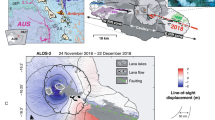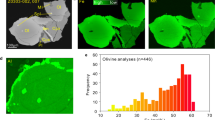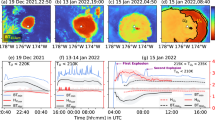Abstract
MONITORING of gravity changes at active volcanoes has considerable potential for understanding magma-chamber dynamics and for detecting eruptive precursors. The technique essentially aims to identify changes in sub-surface mass or density corresponding to departures from the free-air gradient (FAG) or Bouguer-corrected (terrain-corrected) FAG (BCFAG), respectively1,2. Such gravity changes, of the order of 10–100 µgal, have been reported previously through eruptive periods3–6. Here we present a ten-year data set measured at Poás volcano, Costa Rica, in which gravity increases in 1987–1989, relative to both the FAG and the BCFAG, preceded the ash-cloud eruptions of April–May 1989. These results constitute the first unambiguous detection of gravity changes as a precursor to eruption, and we interpret them in terms of the intrusion of an ascending, relatively dense magma body.
This is a preview of subscription content, access via your institution
Access options
Subscribe to this journal
Receive 51 print issues and online access
$199.00 per year
only $3.90 per issue
Buy this article
- Purchase on Springer Link
- Instant access to full article PDF
Prices may be subject to local taxes which are calculated during checkout
Similar content being viewed by others
References
Rymer, H. Proc. Kagoshima Int. Conf. Volcanoes, 358–361 (National Institute for Research Advancement, Tokyo, and Kagoshima Prefectorial Government, Kogoshima, 1988).
Savage, J. C. J. geophys. Res. 89, 1945–1952 (1984).
Rymer, H. & Brown, G. C. J. Volcan. geotherm. Res. 27, 229–254 (1986).
Eggers, A. A. J. Volcan. geotherm. Res. 33, 201–216 (1987).
Dzuirisn, D. et al. J. Volcanol geotherm. Res. 7, 241–269 (1980).
Jachens, K. C. & Eaton, G. P. J. Volcanol. geotherm. Res. 7, 225–240 (1980).
Brown, G. C. et al. Nature 339, 370–373 (1989).
Rymer, H. & Brown, G. C. Nature 311, 243–245 (1984).
Rymer, H. & Brown, G. C. Bull. volcan. 49, 389–398 (1987).
Rymer, H. Geophys. J. R. astr. Soc. 97, 311–322 (1989).
Vargas, C. A. Antologia: el volcan Poás (Univ. Estatal a Distancia, San Jose, Costa Rica, 1979).
Krushensky, R. D. & Escalante, G. Bull. volcanol 31, 75–84 (1967).
Brantley, S. L., Borgia, A., Rowe, G., Fernandez, J. F. & Reynolds, J. F. Nature 330, 470–472 (1987).
Scientific Event Alert Network 12, 7–8 (1987); 14, 15–16 (1989).
Casertano, L. et al. Geofis. Int. 24, 315–332 (1985).
Rymer, H., Morales, L. D. & Brown, G. C. Revista Geologico de America Central 6, 75–102 (1987).
Author information
Authors and Affiliations
Rights and permissions
About this article
Cite this article
Rymer, H., Brown, G. Gravity changes as a precursor to volcanic eruption at Poás volcano, Costa Rica. Nature 342, 902–905 (1989). https://doi.org/10.1038/342902a0
Received:
Accepted:
Issue Date:
DOI: https://doi.org/10.1038/342902a0
This article is cited by
-
Continuous Gravity Observations at Mt. Somma-Vesuvius with a gPhoneX Gravimeter: In-Depth Instrumental Response Characterization and Tidal Model
Pure and Applied Geophysics (2023)
-
Delineating a volcanic aquifer using groundwater-induced gravity changes in the Tatun Volcano Group, Taiwan
Terrestrial, Atmospheric and Oceanic Sciences (2022)
-
Using Crater Lake chemistry to predict volcanic activity at Poás Volcano, Costa Rica
Bulletin of Volcanology (1992)
-
Measures of little gravity
Nature (1989)
Comments
By submitting a comment you agree to abide by our Terms and Community Guidelines. If you find something abusive or that does not comply with our terms or guidelines please flag it as inappropriate.



